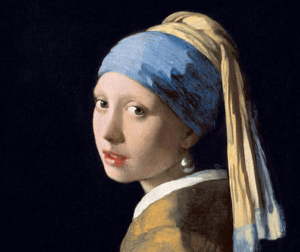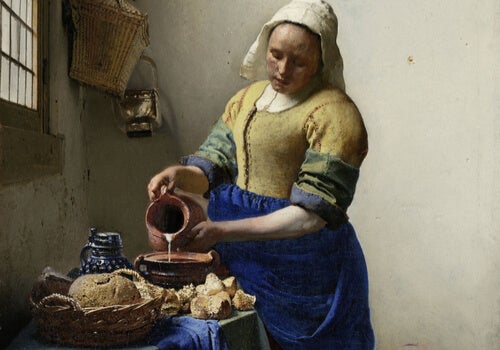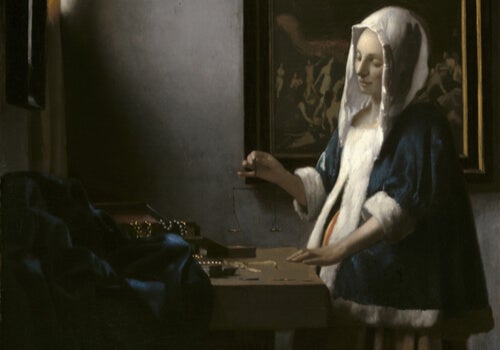Vermeer and the Girl with the Pearl Earring


Reviewed and approved by the psychologist Gema Sánchez Cuevas
As of now, the name Vermeer instantly evokes the image of the girl in the painting Girl with the Pearl Earring. This is because, believe it or not, this is one of the most easily identifiable pictorial works by the general public. This piece is very important, so much so that many people call it the Mona Lisa of the North.
The 17th-century Dutch master’s splendid rendition of an ordinary girl became a universal icon. The painting shows a young woman against a mysterious dark background, with a pearl shining on her lobe.
Vermeer’s art became the most popular of the Dutch Golden Age, as his work is intimate and traditional. He dedicated his mastery to exploring quotidian moments documenting interior spaces, the epitome of the baroque genre.
However, his mastery of pigment and light elevated him beyond the realm of other painters of his time. His talent gave her an inimitable glimpse into the lifestyle he had back then.
The early life of Jan Vermeer
For hundreds of years, people have found inspiration in the paintings of Johannes (Jan) Vermeer. Many people consider him the most respected Dutch painter in history. However, his life and art remain a mystery.
Vermeer was born in 1632 in Delft, the Netherlands. It’s important to mention that no one really knows his exact birthday. He was born into a lower-middle-class family. A fun fact is that Johannes Vermeer van Delft is also known as Joannis ver Meer or Joannis van der Meer.
Moreover, his father, Reijnier Jansz, was a silk weaver craftsman who became an innkeeper and later an art dealer. From these commercial labors, young Vermeer began cultivating a taste for painting.
Now, his mother, Digna Baltus, was supposedly an illiterate housewife. This belief started because Baltus signed an ‘X’ in place of her name on her marriage certificate.

In 1652, Vermeer’s father passed away, so consequently, he inherited both businesses from his father. Before this event, his life was hardly documented, which is why no one knows a lot about his first 20 years of life. Despite very extensive research, no clear answer has been found.
In 1653, Vermeer married Catherina Bolnes and converted to Catholicism. The couple had 15 children (four of them died).
Interestingly, with eleven children running, only two of Vermeer’s paintings directly portray them. Instead, his wife Catherine served as a model for many of his works.
Early work and maturity
In Vermeer’s early career, he focused on making paintings based on history. Also, at this time, he recreated many scenes from the Bible and classical mythology.
Thanks to Maria, his mother-in-law, Vermeer was able to gain access to the richest citizens of Delft, such as Pieter van Ruijven. However, unlike most of his contemporaries, Vermeer never left his hometown and relied solely on local patronage for his commissions.
According to research, Johannes and Catherine lived a happy married life until Vermeer’s untimely death in 1675. He’s believed to have died of a stroke. The couple was married for 22 years.
Furthermore, Catherine supported her husband’s work. Like most artists during that time, Vermeer also accumulated a series of debts that his family had to deal with after he died.
Vermeer’s limited success had to do with the inability to find commissions outside of Delft. Aside from that, he never left the city to commercialize his works and talent, which significantly reduced his opportunities.
Additionally, his limited success has to do with the limitation of the materials he worked with. Unlike Rembrandt, Vermeer didn’t work with prints, which were extremely popular at the time.
The painter’s little success at that historical moment is also due to fortuitous circumstances. For example, the Franco-Dutch war. The fact that the troops constantly invaded the city had repercussions in the art market.
Vermeer: his death and several mysteries
In the year 1675, Master Vermeer fell ill and died while he was running. His burial was officiated in Delft that December. Given his debt, his wife was forced to give up her inheritance and, as a consequence, her creditors confiscated her assets.
Vermeer was the head of a group of artists who met to learn from each other and discuss techniques, called the Delft Artists Guild.
Although his companions highly respected him, he died poor and almost completely unknown for about two hundred years. In the 19th century, the art world rediscovered his work, and that’s when the mysteries surrounding his life resurfaced.
How did Vermeer master the art of creating clarity in his paintings? This is something many people wonder about since they’re easily mistaken for photographs. Perhaps the reason why his paintings took him so much to make was precisely because he worked hard to capture so much light and shadow. How was he able to accomplish that, though?

According to some, Vermeer’s dominance was like no one else’s. Others say that he created an early type of camera, called a “camera obscure,” which allowed him to “stop time” and study the effects of light. On the other hand, some find fault with his paintings or attribute them to someone else.
Vermeer usually painted portraits or scenes of people doing their daily work. Only two landscapes are attributed to him. This painter understood the effect of light and reflection on a person or an object. Actually, art experts attribute the realism of his paintings to this fact. Essentially, Vermeer recognized that the eye doesn’t see the entire object and its actual color, due to the effects of light and reflection.
Girl with the Pearl Earring
Looking closely at Vermeer’s paintings, it’s possible to see his unmistakable signatures, the way he used the light, and his ability to capture real life. Girl with a Pearl Earring is one of his most famous works.
The painting shows a girl whose slope prodigiously reflects the light, while she turns her gaze towards the painter. In this painting, you can see the shadows projected on the girl’s cheek and nose as they fade into the background.
The painting inspired Tracy Chavalier’s 1999 novel and film adaptation.
There’s no doubt that this is one of the most emblematic paintings in the history of art – it’s a symbol that anyone can enjoy, no matter if they know about art or not.
All cited sources were thoroughly reviewed by our team to ensure their quality, reliability, currency, and validity. The bibliography of this article was considered reliable and of academic or scientific accuracy.
- Lapoujade, M. N. (2006). La imaginación estética en la mirada de Vermeer. Herder.
- Westermann, M. (2003). Vermeer y la imaginación interior. In Vermeer y el interior holandés (pp. 59-93). Museo Nacional del Prado.
- Lamelas, G. F. (2011). Arte y clases sociales; Vermeer y Meunier. Revista de Claseshistoria, (11), 10.
This text is provided for informational purposes only and does not replace consultation with a professional. If in doubt, consult your specialist.








